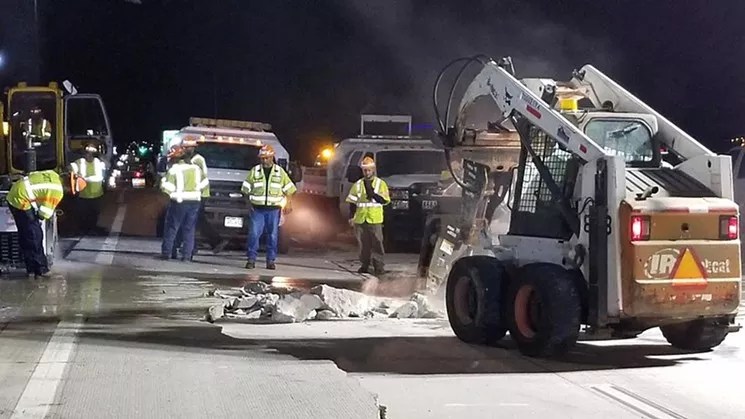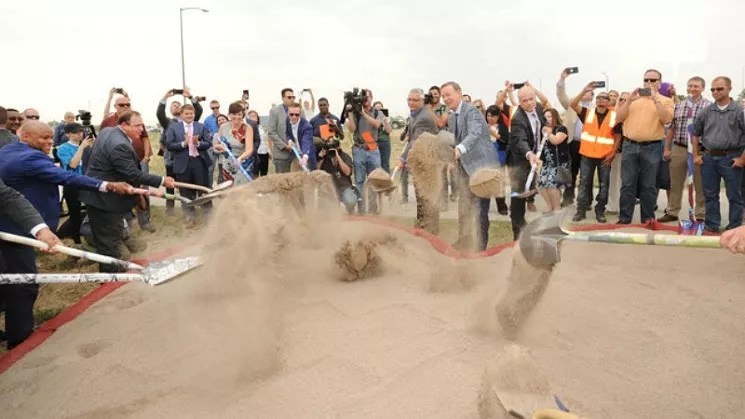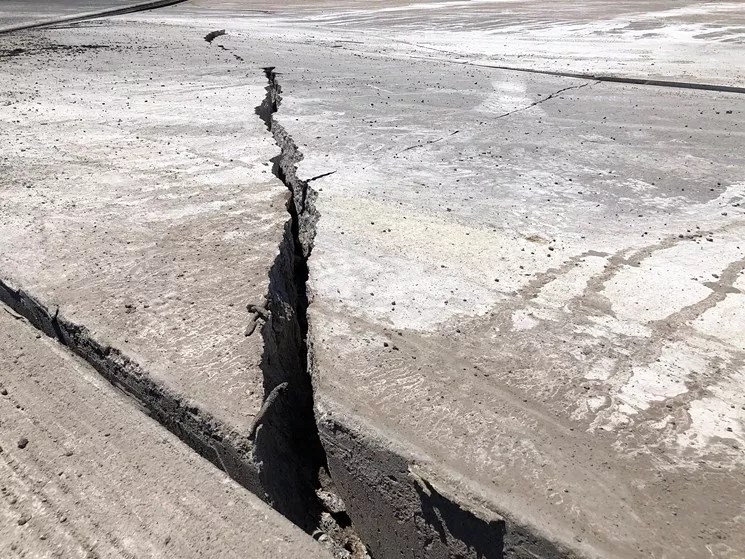

Audio By Carbonatix
The 24th annual Reason Foundation report on the condition of America’s highways contains plenty of bad news for Colorado drivers. The state doesn’t finish among the top ten in any category, and Baruch Feigenbaum, Reason’s assistant director of transportation policy and the lead author of the study, agrees that its performance richly deserves being dubbed “mediocre.”
“I think that’s a great description,” says Feigenbaum, whose co-writers were M. Gregory Fields and Spence Purnell. “Overall, Colorado finished 36th in the country, which is certainly not great” – and it’s also five slots lower than in 2018. He adds, “The state does a few things fairly well, but there’s room for improvement in a lot of areas.”
The Colorado Department of Transportation offers little push-back regarding the conclusions in the report. A statement provided to Westword focuses on lousy finishes for pavement on interstates; Colorado ranks 28th in the U.S. for urban areas and a humiliating 47th, or fourth-worst, for rural zones. “The findings…come as we are wrapping up conversations with citizens across the state about their transportation needs and priorities,” the department points out. “We’ve heard loud and clear that the pavement condition along our state’s roads is a big concern for Coloradans, and that real world experience is echoed in the findings of this report. As we integrate what we’ve learned into our transportation plan, fixing urban and rural roads will be a top priority.”
The categories in which Colorado stands out are few.
We’re thankful for you. Are you thankful for us?
We feel thankful for our staff and for the privilege of fulfilling our mission to be an unparalleled source of information and insight in Denver. We’re aiming to raise $50,000 by December 31, so we can continue covering what matters most to this community.
Help us continue giving back to Denver.
“The state’s best ranking was in the percentage of structurally deficient bridges,” Feigenbaum notes. “We count the number of bridges that are in a safe condition and are generally well-maintained, and Colorado finished 13th. That’s important, because we don’t want to see any worst-case scenarios like that bridge collapse in Minneapolis in 2007” – in which thirteen people were killed and 145 suffered injuries.
Bridge health in the state should be further enhanced by a $12.4 million grant from the U.S. Department of Transportation announced on August 29. The project is slated to replace fourteen culverts in western and southern Colorado on routes such as Highway 9, U.S. 24 and U.S. 350.
Likewise, Feigenbaum goes on, “the overall fatality rate of 23rd is pretty solid for a state that’s fairly rural outside the metro areas. We tend to see the worst fatality rates in more rural states; places like Montana tend to struggle with it. There’s also a high fatality rate in Florida, which is a less rural state.” But he acknowledges that landing in 13th and 23rd place for these brackets falls short of outstanding, and he feels it “would be good for the state to focus even in these areas.”

Then-Colorado governor John Hickenlooper and Denver Mayor Michael Hancock were among the dignitaries who took part in the Central 70 project groundbreaking on in August 2018.
Other subjects are considerably more problematic, from his perspective. “Generally, Colorado struggles in three major areas. The first one is overall spending. The state ranks in the bottom twenty for three of the four spending metrics: total disbursements per mile [33rd], capital-bridge disbursements per mile [34th] and maintenance disbursements per mile [32nd]. That’s really concerning. A state like Colorado should do better than that.”
By the way, in the fourth spending metric, administrative disbursements per mile, Colorado is only slightly better, coming in at 27th.
In 2018, two highway-funding ballot measures, propositions 109 and 110, attempted to address this situation. But both failed, as have many such initiatives put forward in the age of TABOR, The Taxpayer Bill of Rights, which requires tax increases to be approved by voters. Feigenbaum is familiar with TABOR’s impact on Colorado political life, but, he stresses, “There’s certainly a benefit to increasing the revenue for highways. I don’t know if it has to be a gas tax or if it could be tolling – and I know there’s been some tolling in Denver. But there are also some efficiencies that the Colorado Department of Transportation could look at, such as adopting more of a cost-benefit process when it comes to selecting projects. States that take a detailed look at how much it costs to build a roadway, including right-of-way acquisition versus the benefits, tend to do a little bit better in the report. We think it’s because they’re putting the most resources toward the biggest problems.”
He also touts public-private partnerships of the sort that have come under closer scrutiny after a section of Highway 36’s partial collapse in July. He thinks that shifting away from such funding tactics based on this single incident would be premature, particularly given his confidence that “there’ll be a way for the state to get money back from the private partner.” (Ames Construction and Granite Construction designed and built the highway’s expansion, and Plenary Roads Denver is its concessionaire.) In Feigenbaum’s view, “These kinds of partnerships can be very helpful, and I think the state should continue to look at them.”
As for the smoothness and quality of highway pavement in Colorado, the second problem area, Feigenbaum believes that the state “really needs to look at exactly why the rural pavement is in such bad shape. Both the states of Virginia and Georgia had an issue in this area, too, but they found a way to get their pavement in really good shape. And in Virginia’s case, they have winter weather and snow – not as much as in Colorado, but there could be some lessons learned.”

One of the cracks in the roadway that led to the temporary closure of Highway 36 in July.
Wintry weather “can certainly be a complicating factor” when it comes to pavement, he concedes. “The biggest part of that is the freeze-thaw cycle. But states such as North Dakota, which may have even harsher conditions than Colorado does, tend to do well in pavement conditions. Maybe we wouldn’t expect Colorado to be in the top ten in this area, but the state can certainly do better than 47th.”
Also worthy of concern from Feigenbaum’s perspective is Colorado’s 37th-place ranking in problem area number three, urban congestion, “especially when you consider that the only metro area that has really bad congestion in the state is Denver. That shows the state needs to look at reducing congestion there. That could mean new capacity – both unpriced lanes and the tolling aspect. Spending resources on those projects rather than rural areas might get Colorado a better bang for its buck.”
Given this philosophy, it’s no surprise that Feigenbaum is bullish on controversial efforts such as Central 70, whose timeline is so uncertain that even CDOT can’t definitively say it will be done by 2022, as hoped. “They’re looking to add some lanes on C-470, too, which is good,” he maintains. And to those frustrated by what seems to be simultaneous construction on every major artery running in and out of metro Denver, he says, “The reality is that when a metro area is growing this fast, you need more capacity, and using pricing to address congestion is going to be necessary. So I think motorists need to be patient. Once these projects are complete, they’re going to be much better highways than they were before.”
The bottom line for Colorado, as Feigenbaum sees it: “The system can definitely be improved.”
Here are Colorado’s rankings in all the categories included in the report:
Overall Rank: #36
Overall Rank in Previous Report: #31
Total Disbursements per Mile: #33
Capital-Bridge Disbursements per Mile: #34
Maintenance Disbursements per Mile: #32
Administrative Disbursements per Mile: #27
Rural Interstate Percent in Poor Condition: #47
Urban Interstate Percent in Poor Condition: #28
Rural Other Principal Arterial Percent in Poor Condition: #27
Urban Other Principal Arterial Percent in Poor Condition: #33
Urban Area Congestion: #37
Structurally Deficient Bridges, Percent: #13
Overall Fatality Rate: #23
Rural Fatality Rate: #33
Urban Fatality Rate: #32
Click to read the Reason Foundation’s 24th annual highway report.